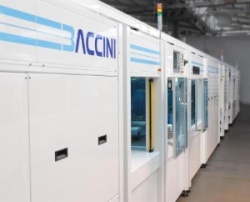Applied Materials, Inc. today announced at the SNEC 2010 PV Power Expo that its Esatto Technology™ is expected to be used in more than 2 gigawatts of annual cell manufacturing capacity in the next few months at customer sites in China, Taiwan and Europe.
 Applied Materials' Esatto Technology, a multi-step printing capability for its Baccini back-end solar cell processing systems, has demonstrated 0.46% absolute cell efficiency gains at customer sites.
Applied Materials' Esatto Technology, a multi-step printing capability for its Baccini back-end solar cell processing systems, has demonstrated 0.46% absolute cell efficiency gains at customer sites.
Customers have demonstrated 0.46% absolute cell efficiency gains with Esatto Technology, and up to a 14% reduction in consumption of silver printing paste. This combination of higher efficiency and reduced material expense is projected to lower manufacturing cost by over 3 cents-per-watt and deliver a return on investment in as little as 8 months.
Esatto Technology is a high precision, multi-step printing capability for Applied’s market-leading Baccini™ back-end solar cell processing systems. This production-proven screen printing technology is used to fabricate advanced contact structures in crystalline silicon (c-Si) solar photovoltaic (PV) cells.
“Our Esatto Technology demonstrates Applied’s unmatched ability to overcome the challenges in integrating new cell technologies and to provide easy-to-implement, cost-effective solutions to our customers,” said Davide Spotti, vice president and general manager of Applied’s Baccini Cell Systems division. “We’re seeing an enthusiastic response from cell makers because they can drive their efficiency roadmaps using their existing production equipment and process flows.”
Key to Applied’s Esatto Technology is its proprietary illumination and pattern recognition system which provides the critical accuracy and repeatability to enable precise alignment between multiple screen-printed layers. In a study at Germany’s prestigious Fraunhofer Institute, Esatto Technology for double-printed front contacts enabled significant out-of-the-box improvements in absolute cell efficiency and printing paste consumption. Applied’s Esatto Technology also offers cell manufacturers a simple path to upgrade their Baccini lines to implement selective emitter structures, which are low-resistivity regions beneath the contacts. By creating these structures, customers can harvest more of the light spectrum and boost cell efficiency even further.
Source: http://www.appliedmaterials.com/